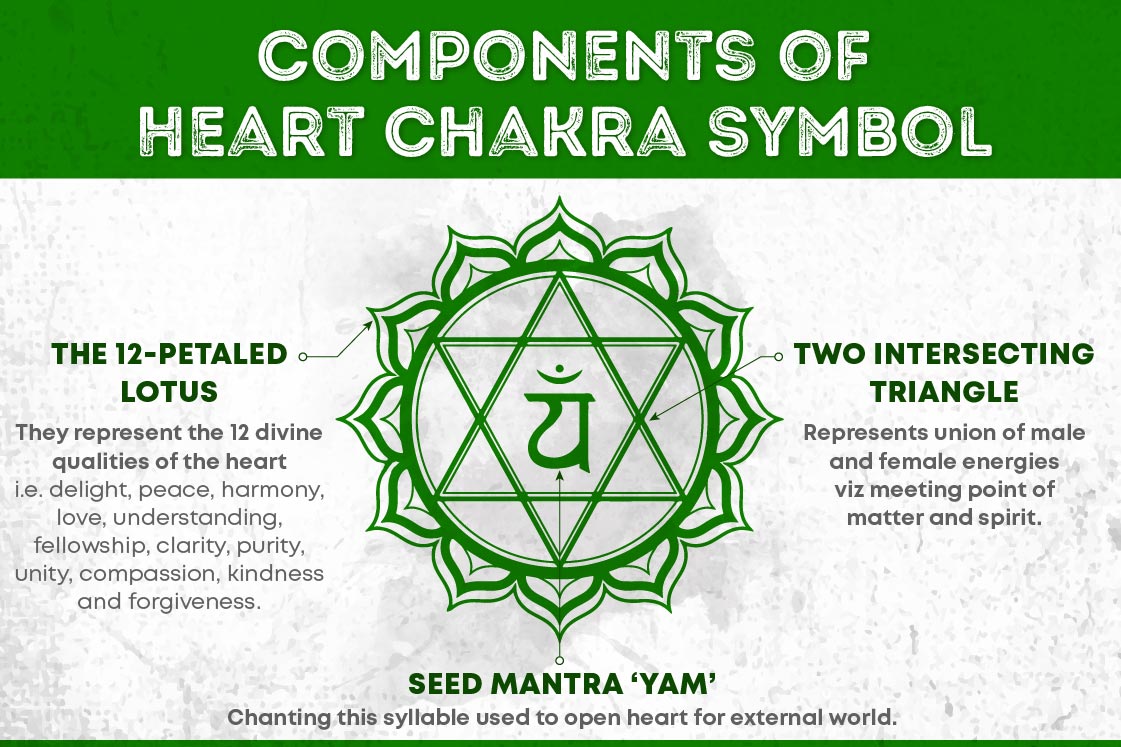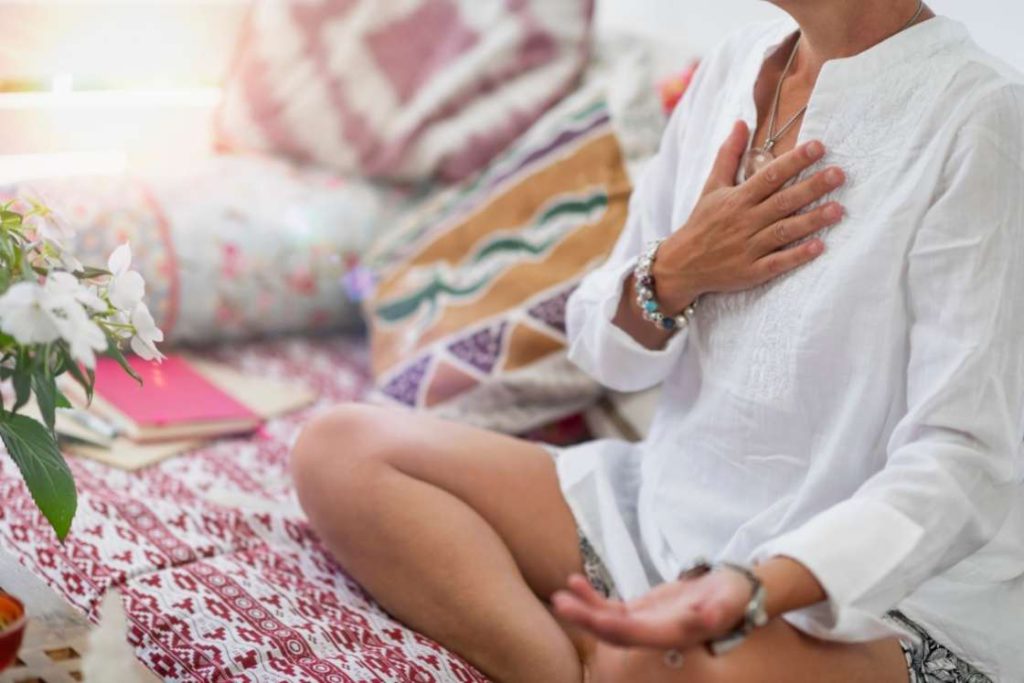- Meaning
- Location
- Color
- Symbol
- Characteristics
- Balance heart chakra
- Blocked heart chakra
- How to Balance?

The Heart Chakra at a Glance
| Sanskrit Name – Meaning | Anahata – unstruck sound |
| Location | Centre of chest |
| Color | Green |
| Seed Mantra | YAM |
| Element | Air |
| Characteristics | Harmony with nature, unconditional love, positive neutrality, harmonious relationships |
| Symptoms of blocked | Headaches, blurred vision, sinus issues, eyestrain, seizures, hearing loss, hormone function |
| Healing crystal | Green Aventurine, Prehnite, Emerald |

The Heart Chakra, known as Anahata in Sanskrit, is the fourth energy centre in the body’s chakra system. Located at the centre of the chest, it governs love, compassion, empathy, forgiveness, and our ability to connect both with others and with ourselves.
Anahata serves as a bridge between the lower chakras, which relate to physical and emotional needs, and the upper chakras, which guide spiritual growth and higher awareness. This central position makes it vital for creating balance between body and spirit.
When the heart chakra is open and balanced, it allows unconditional love to flow freely, encouraging emotional healing, acceptance, and inner peace. It helps soften the ego shifting us from fear and control to unity and love. But when blocked, it can lead to emotional pain, isolation, and difficulty in relationships.
By awakening the heart chakra, we align with the energy of universal love, fostering spiritual growth, emotional stability, and deep connection with the world around us.
Anahata chakra meaning
The word Anahata means “unstruck” or “unbeaten sound”. It symbolises a subtle inner vibration that arises without physical contact representing pure, unconditional love that exists beyond external conditions.
This sound is often linked to OM, the primordial sound of the universe. It is said that OM continues to resonate silently, just as it did at the time of creation. In deep meditation, one may begin to perceive this vibration within the heart, offering a sense of peace and unity with the cosmos.
Practices like Nada Yoga (yoga of sound) and Kriya Yoga can help activate the heart chakra by stilling the mind and awakening this inner sound, deepening your connection to yourself and others.
Location and associated organs

The Heart Chakra is located in the centre of the chest, between the right and left lungs, slightly to the left of the breastbone (sternum). From the back, it aligns with the eighth thoracic vertebra (T8).
This area holds deep significance as it connects closely with vital organs such as the heart and lungs, both essential for life and energy circulation. The flow of oxygen and prana (life force) through the breath plays a key role in keeping the heart chakra balanced. Pranayama (yogic breathing) is especially effective in cleansing and energising this chakra.
The heart chakra is also linked to several body parts and systems, including:
- Upper back and thoracic cavity
- Lower region of the lungs
- Skin, hands, and arms
- Cardiovascular, respiratory, and immune systems
An important gland associated with this chakra is the thymus, located just above the heart. The thymus plays a major role in immune function and is sometimes referred to as the “higher heart chakra” or “seat of the soul”. It symbolises spiritual development, unconditional love, compassion, and forgiveness.
Maintaining balance in this chakra supports both emotional well-being and physical health by harmonising the body’s energy with the breath and the rhythm of the heart.
Join Our 40-Day Live Kundalini Yoga Teacher Training Course
Heart chakra colour and its significance
Each chakra in the body is associated with a specific colour and vibrates at a unique frequency, influencing your physical, emotional, and spiritual state.
The soul is tinged with the color of its thoughts.
The Heart Chakra is associated with the colour green, symbolising healing, balance, compassion, safety, and growth. It reflects emotional renewal, unconditional love, and the power to transform pain into peace.
Green also represents harmony between the physical and spiritual aspects of life, mirroring the heart chakra’s role as a bridge between the lower and upper chakras.
Exposure to green especially in nature during the morning can stimulate the release of cortisol, helping regulate your sleep-wake cycle and improving emotional clarity. This makes green not just a colour of the heart chakra, but also a natural aid for mental and emotional balance.
Heart (anahata)chakra symbol

Each of the seven chakras is represented by a unique symbol that reflects its core qualities and functions.
The Heart Chakra symbol consists of a circle with twelve lotus petals and two intersecting triangles forming a six-pointed star (Shatkona).
Here’s what each element represents:
- Twelve Lotus Petals: These petals symbolise the twelve qualities of the heart when this chakra is balanced, including love, joy, peace, patience, kindness, and compassion.
- Intersecting Triangles (Shatkona): One triangle points upward, representing the rising of matter (spiritual growth), and the other points downward, symbolising the descent of spirit into the physical world. Their intersection signifies the union of physical and spiritual energies within the heart.
- Animal Symbol – Black Antelope: In Hindu tradition, the heart chakra is associated with Vayu, the deity of air, who rides a black antelope. The antelope symbolises lightness, joy, and restlessnessalways seeking the source of bliss, just as the heart seeks unconditional love.
Together, the elements of this symbol reflect the heart chakra’s role as the centre of love, unity, and the meeting point of body and spirit.
The energy frequency and seed mantra
Each chakra emits energy at a specific frequency, corresponding to the visible spectrum of light and sound.
The Heart Chakra vibrates at 639 Hz, a frequency known to promote emotional healing, harmony in relationships, and inner peace. Listening to music tuned to 639 Hz can help reduce anxiety, soothe emotional pain, and support connection with others.
The seed mantra (Bija mantra) of the heart chakra is “YAM” (pronounced yum). Chanting this sound activates the energy of the heart centre and enhances the flow of Prana (life force) through the body, particularly through the lungs and chest.

The element of the heart chakra is air (Vayu) light, mobile, and expansive. This element governs qualities such as freedom, softness, openness, and lightness. Because of this, the heart chakra is especially dominant in individuals with a Vata dosha (air-energy constitution) in Ayurveda.
Chanting “YAM” while focusing on the heart centre can help open emotional blockages and restore balance to this vital chakra.
Characteristics of heart(anahata)chakra
The Heart Chakra, or Anahata Chakra, is the centre of compassion, empathy, forgiveness, trust, and emotional connection. It allows you to embrace life as it is whether situations are in your favour or not with acceptance and grace.
This chakra marks the shift from a materialistic identity to a spiritual one, where you begin to identify with your higher self also known as the soul, God, Source, or Cosmic Intelligence. When balanced, the heart chakra guides you with unconditional love and a deep sense of inner peace.
Its subtle voice affirms:
“I am worthy of love. I lovingly allow joy to flow through my mind, body, and experience.”
Here are the key qualities that support an open and awakened Heart Chakra:
1. Release Expectations
When we hold on to expectations and outcomes, we often experience disappointment and emotional pain. The heart chakra encourages living with detachment focus on action, not the result, as taught in Karma Yoga. Letting go of expectations opens the path for unconditional love to flow.
2. Release Attachments
Attachments stem from desire and fear the fear of loss brings suffering. Recognising that joy and sorrow often arise from the same source helps in surrendering the ego. To evolve spiritually, one must move beyond attachments and transform love into something divine and selfless.
3. Trust your Relationships
Trust is a cornerstone of heart-centred living. The heart chakra teaches that people act from their own limitations, priorities, and fears not always to hurt us. Awareness of this builds deeper connection and resilience in relationships.
4. Forgiveness
True freedom lies in letting go. Holding on to anger or hurt only closes the heart. Forgive those who caused pain, whether intentionally or not. Forgiveness is not about them; it’s about setting yourself free.
How to know if the heart chakra is balanced?

When the heart chakra (Anahata) is open and balanced, love and compassion flow naturally. You begin to accept yourself and others, forgive easily, and experience a deep sense of peace.
A balanced heart chakra allows emotional pain to be released through unconditional love. In yogic tradition, the jiva atman (individual soul) is believed to reside in the heart centre serving as the bridge between the material self and the divine self. As this energy centre opens, inner peace and spiritual harmony begin to blossom.
Signs of a Balanced Heart Chakra:
- Feeling connected with nature
- Expressing unconditional love without expecting anything in return
- Maintaining a state of positive neutrality in difficult situations
- Building harmonious relationships with others
- Being nonjudgmental toward yourself and others
- Showing genuine compassion and empathy
- Experiencing deep inner peace and emotional stability
Imbalanced heart chakra: symptoms and causes
An imbalanced heart chakra (Anahata) disrupts your ability to give and receive love, often resulting in emotional, mental, and physical distress. It may lead to grief, anger, jealousy, fear of betrayal, and even hatred towards yourself and others.
This imbalance can manifest as:
- Emotional signs:
- Loneliness and isolation
- Jealousy and bitterness
- Inability to forgive
- Passive-aggressive behaviour
- Difficulty in giving or receiving love
- Being judgmental and critical
- Lack of empathy
- Smothering or controlling tendencies
- Physical symptoms:
- Heart-related issues (palpitations, high or low blood pressure)
- Asthma, bronchitis, or breathing problems
- Weakened immune system
- Poor blood circulation
- Chest tightness or lung infections
When the heart chakra is blocked or overactive, your energy flow is disrupted, affecting not only your emotional health but also your overall vitality. This may leave you feeling hopeless, rejected, or disconnected from others, resulting in loss of meaningful relationships.appen because of the imbalanced heart chakra.
1. Overactive heart chakra
An overactive heart chakra occurs when too much energy flows through this centre, leading to emotional overwhelm and lack of boundaries.
Signs of an overactive heart chakra include:
- Being overly demanding in relationships
- Putting others’ needs above your own, leading to emotional exhaustion
- Feeling like a victim or becoming overly dependent on others
- Losing personal boundaries and becoming overly involved in others’ emotions
- Emotional instability, possessiveness, or getting hurt easily
This imbalance can create codependent relationships, where your identity becomes entangled with others, causing confusion and emotional burnout.
2. Blocked (underactive) heart chakra
A blocked or underactive heart chakra results in emotional coldness, difficulty trusting, and a fear of intimacy or love.
Signs of a blocked heart chakra include:
- Emotional numbness or inability to express feelings
- Fear of betrayal or rejection
- Holding on to past pain, grief, or heartbreak
- Difficulty trusting others
- Being overly self-critical or lacking self-worth
- Becoming emotionally unavailable or overly guarded
This suppression often stems from unresolved emotional wounds or fear of vulnerability, causing a deep sense of disconnection from yourself and others.row, and grief and do not trust others, become judgmental, critical, and intolerant.
How to balance heart (anahata)chakra?
Balancing the Heart Chakra (Anahata) restores emotional harmony, supports loving relationships, and deepens your connection with self and others. Below are five powerful ways to open and align this chakra:

1. Incorporating karma yoga principles
Karma Yoga teaches selfless action without attachment to the outcome. Practising these principles fosters detachment, emotional balance, and an open heart:
- Experience without attachment: Accept each moment as it is, without comparing it to the past or future. Nothing is permanent.
- Let go of the past: Release emotional attachments to people or situations that no longer serve your growth.
- Detach from outcomes: Stop chasing control. Live fully in the present moment without worrying about results.
- Let go of emotional attachment: Pain is part of life, but suffering is optional. By letting go of clinging, the heart can heal and open.
2. Practice pranayama and heart opening yoga poses
Pranayama helps regulate the breath and prana, improving heart-lung function and promoting inner calm. Combine breathwork with backbending poses to physically and energetically open the heart space.
Recommended pranayama:
Heart-opening yoga poses:
- Half Camel Pose (Ardha-Ushtrasana): Half Camel Pose is a deep backbend for your upper back, and literally and metaphorically opens up your heart space.
- Wheel Pose (Urdhva Dhanurasana): Wheel Pose develops mobility and flexibility in your spine and hip flexors as well as creating space in your heart.
- Bridge Pose (Setu Bandha Sarvangasana): Bridge Pose is a gentler variation of Wheel Pose and it begins to create flexibility and strength in your spine.
- Reverse warrior pose: Warrior 1 Pose strengthens your quads while creating flexibility in your hips.
- Upward Facing Dog Pose ( Urdhva Mukha asana): Upward-Facing Dog strengthens and tones your arms while creating flexibility in your spine.
- Bow Pose (Dhanurasana): Bow Pose generates mobility in your spine as well as flexibility in your hip flexors.
3. Practice meditation with heart chakra mudra
Meditation helps focus your awareness on the heart centre, especially when combined with a hand gesture (mudra).
To balance the heart chakra, holding hands in Apana vayu mudra and bringing your awareness to the heart center is the easiest way. This mudra has the power to ease the pain around the chest area and improves blood circulation.
4. Using heart chakra stones
Crystals that resonate with the heart chakra frequency can restore emotional balance and promote compassion.
- Rose Quartz: Stone of Unconditional Love
- Rhodochrosite: Stone for Selfless Love and Compassionate Heart.
- Emerald: Stone of Successful Love
- Rhodonite: Stone of Self Love and Unconditional Love referred to as an emotional balancer.
- Green Aventurine (Stone of Opportunity)
- Green Jade: Dream Stone and Stone of Fidelity
- Amazonite: Stone of Hope and Courage, supports both the heart and throat chakra.
- Prehnite: Stone of Unconditional Love and Healing
5. Add heart chakra food in diet and do lifestyle changes
Green vegetables and fruits are your great companion to open up your blocked heart chakra.
- Eat green vegetables like leafy greens, salad greens, pot herbs, brussels sprouts, spinach, and kale.
- Use aromatherapy oils such as Sandalwood, Jasmine, Lavender, and Geranium.
- Listen to the sound of wind instruments like flute, saxophone, etc.
- Wear 15 Mukhi Rudraksha and gemstones like Emerald.
Conclusion
A balanced Heart Chakra transforms your inner world allowing you to live with love, compassion, and emotional freedom. When this chakra is open, you no longer seek love with conditions or expectations. Instead, you naturally forgive, accept, and extend kindness to others, simply because it flows from within.
Nurturing your heart chakra is not just about emotional healing it’s about becoming a channel of unconditional love and light in a world that needs it the most.
FAQs about the heart chakra
1. Which side of the body is the heart chakra located?
The heart chakra is located at the centre of the chest, slightly towards the left side, behind the breastbone.
2. What emotion blocks the heart chakra the most?
Grief is the most common emotion that blocks the heart chakra, followed by resentment, betrayal, and fear of rejection.
3. Can heart chakra imbalance cause physical pain?
Yes, an imbalanced heart chakra can cause chest tightness, upper back pain, and emotional stress that manifests physically.
4. Is crying a sign of heart chakra opening?
Yes, crying during meditation or emotional release is a natural sign that your heart chakra is opening and healing.
5. How long does it take to open the heart chakra?
It varies per person. With consistent practice of meditation, yoga, and self-love, it may take a few weeks to several months.
6. What essential oils help open the heart chakra?
Rose, lavender, jasmine, and geranium are the most effective essential oils for activating the heart chakra.
7. Can sound healing activate the heart chakra?
Yes, listening to 639 Hz music or heart-centred chants like “YAM” can help activate and balance the heart chakra.
8. What happens during a heart chakra awakening?
You may feel deep empathy, forgiveness, emotional release, and a strong sense of connection with others and the universe.
9. Can heart chakra healing help with relationship problems?
Yes, healing the heart chakra improves emotional openness, trust, and communication in relationships.
10. Can affirmations help unblock the heart chakra?
Yes, repeating affirmations like “I am worthy of love” or “I forgive and release all past hurt” helps clear blockages.





Very good explanation about the topic. Well done indeed!
The heart chakra is the 4th not the 5th chakra
Very nicely written and explained.